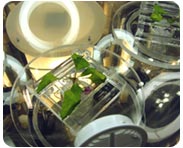|


|
|
Artist
Phil Ross explores the intersection of technology
and life in his "space age" garden installation.
|

|
In
October 2002, we put a new face on our Life Sciences section.
Our newest exhibit collection, Traits of Life, reflects some
of the latest theories in modern biology without losing sight
of the fundamentals. After three years of research and experimentation,
our team of scientists, exhibit developers, designers, writers,
and evaluators unveiled over thirty new and revitalized biology
exhibits and demonstrations.
With
a mind toward revealing the characteristics shared by all
living things, the Traits collection focuses on four defining
features: All life reproduces, uses energy, evolves over time,
and consists of cells and DNA. Each section is designed to
help visitors see past the diversity of living things to the
underlying unity connecting us all.
This
selection was not intended to be all-inclusive. "Biologists
point to anywhere from two to twenty-two traits of life, depending
on their area of study," says Charles Carlson, Director
of Life Sciences. "We compressed the list of traits to
a reasonable number that we could exhibit."
What
are the essential elements of life? What sorts of things would
you look for to help you distinguish living from inanimate
matter? Encouraging visitors to think about these things is
what the Traits collection is all about. Our planet is filled
with millions of species in seemingly endless variations of
size, shape, and color. Yet however diverse these species
appear—from a bacterium consisting of a single cell to
a human being composed of a hundred trillion cells—all
follow the same biological laws.

|
|
You'll
see how cells group together to form specialized
tissue in the Zoom in on Cells exhibit.
|

|
"This
collection of exhibits is groundbreaking in its focus on the
uniformity of life rather than on the diversity," says
Kathy McLean, the museum’s Director of the Center for
Public Exhibition. "As visitors explore these exhibits,
they’ll see how closely related all living things are."
Traits
of Life, the outgrowth of a research grant from the National
Science Foundation, with additional support from the Genentech
Foundation for Biomedical Sciences, the National Endowment
for the Arts, and The Camille and Henry Dreyfus Foundation,
Inc., celebrates the wonder and diversity of life while revealing
the underlying chemistry shared by all living things. The
grant also supports a traveling show hosted by museums around
the country. The traveling show features about twenty exhibits
selected from the core group of Traits exhibits, along with
a station equipped for biology demonstrations, including DNA
extraction and sea urchin fertilization.
At
the Exploratorium Traits collection, colorful bacteria, glowing
worms, zebrafish embryos, and mutant fruit flies are among
the organisms on display. Just as scientists prefer to use
a particular organism to study a particular biological question,
each of these organisms represents a specific property. The
bacteria in the Living Color exhibit demonstrate how some
single-celled organisms use pigments to capture the sun’s
energy. The one-millimeter-long, soil-dwelling nematodes in
Glowing Worms gleam with genes taken from a sea jelly, evidence
of the similarity of genetic material in different species.
The transparent body of the zebrafish in Look Inside a Zebrafish
Egg displays the growth and development pattern common to
embryos, and the fruit flies in the Mutant Flies exhibit show
how genes shape physical attributes.
The
strategies these organisms use to survive and reproduce are
as varied as their appearance, but the chemistry that governs
their behavior is not. As scientists decode the genomes of
more and more organisms, they’re finding the same genes
at work in more and more species. We human beings, it turns
out, share about 99 percent of our 30,000 genes with mice.
We even have the genes to grow a tail, although we seem to
have lost the command to do so.
"The
more we find out about the genetics of living things,"
says McLean, "the more we understand that all life is
related. It’s not some kind of New Age notion that the
squirrel is my sister or the slime mold my cousin; it’s
really true. In talking to visitors, we’re finding out
that these exhibits encourage them to ask questions about
what life really is. And ‘what is life?’ is probably
one of the most profound questions we can ask."
<<Back
to introduction
©
Exploratorium
| The museum of
science, art and human perception|
Traits
of Life
|

